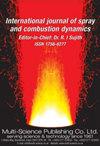Experimental study on flash-boiling spray structure of multi-hole gasoline direct injection injector in a constant volume chamber
IF 2.1
4区 工程技术
Q3 ENGINEERING, MECHANICAL
International Journal of Spray and Combustion Dynamics
Pub Date : 2020-07-01
DOI:10.1177/1756827720932431
引用次数: 2
Abstract
The macroscopic and microscopic characteristics of flash-boiling spray were experimentally investigated with various optical measurement techniques. The effects of ambient pressure and fuel temperature on flash-boiling characteristics in multi-hole gasoline direct injection injector were analyzed. The analysis was focused on the spray structure and atomization droplet size distributions. In order to increase the understanding of the flash-boiling spray targeting, three injectors with different spray patterns were investigated under strong flash-boiling condition. The results show that ambient pressure and fuel temperature have significant influence on flash boiling. Both lower ambient pressure and higher fuel temperature could accelerate the flash-boiling process. For the macroscopic characteristics, similar influences could be found with the ambient pressure decreased by 0.4 bar and the fuel temperature increased by 10°C. Further, significant difference could be found within cold-jet spray and strong flash-boiling spray, such as the spatial structure. The spray structure always turns from hollow cone into solid when flash boiling occurs. With a higher fuel superheat degree, the spray droplet distribution moves toward smaller sizes and let the larger droplets reduce due to the promotion of atomization. For the strong flash-boiling spray, the Sauter mean diameter has decreased by 50% compared with cold-jet spray. There is a corresponding relationship between collapsed flash-boiling spray target and weighted geometric center of the injector. Spray collapse could be avoided by increasing the plume distance.定容室内多孔汽油直喷器闪蒸喷雾结构的实验研究
采用多种光学测量技术对闪蒸喷雾的宏观和微观特性进行了实验研究。分析了环境压力和燃料温度对多孔汽油直喷器闪沸特性的影响。重点分析了喷雾结构和雾化液滴尺寸分布。为了加深对闪蒸喷雾靶向的理解,在强闪蒸条件下对三种不同喷雾方式的喷射器进行了研究。结果表明,环境压力和燃料温度对闪蒸有显著影响。较低的环境压力和较高的燃料温度都可以加速闪蒸过程。对于宏观特性,当环境压力降低0.4巴,燃料温度升高10°C时,可以发现类似的影响。此外,冷射流和强闪沸射流在空间结构等方面存在显著差异。当发生闪蒸时,喷雾结构总是从空心锥变成固体。随着燃料过热度的升高,喷雾液滴分布向较小的尺寸移动,并由于雾化的促进而使较大的液滴减少。对于强闪速沸腾喷雾,Sauter平均直径比冷射流减少了50%。塌缩的闪蒸喷雾靶和喷射器的加权几何中心之间存在对应关系。通过增加羽流距离可以避免喷雾塌陷。
本文章由计算机程序翻译,如有差异,请以英文原文为准。
求助全文
约1分钟内获得全文
求助全文
来源期刊

International Journal of Spray and Combustion Dynamics
THERMODYNAMICS-ENGINEERING, MECHANICAL
CiteScore
2.20
自引率
12.50%
发文量
21
审稿时长
>12 weeks
期刊介绍:
International Journal of Spray and Combustion Dynamics is a peer-reviewed open access journal on fundamental and applied research in combustion and spray dynamics. Fundamental topics include advances in understanding unsteady combustion, combustion instability and noise, flame-acoustic interaction and its active and passive control, duct acoustics...
 求助内容:
求助内容: 应助结果提醒方式:
应助结果提醒方式:


